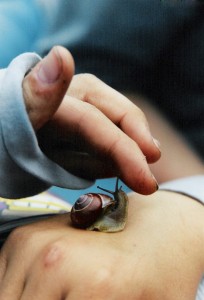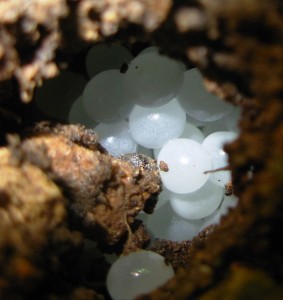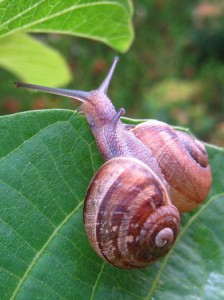 It is springtime, and the snails are upon us. They are upon the lemon leaves, and the stucco walls, and the umbrella stand. Somehow, they are upon the closet doors, which happen to be inside the house. They are upon the roof rack of the car as it travels six hundred miles north to Mount Shasta, and they emerge unscathed.
It is springtime, and the snails are upon us. They are upon the lemon leaves, and the stucco walls, and the umbrella stand. Somehow, they are upon the closet doors, which happen to be inside the house. They are upon the roof rack of the car as it travels six hundred miles north to Mount Shasta, and they emerge unscathed.
Beware the person who steps barefoot into the grass at midnight. The ten yards to the bathroom now seems much preferable to the sickening crunch of a shell beneath the heel.
This is the first place I’ve lived that had so many snails. During the first few years in this house, I heard an odd sound at night, a cross between a scratch and a squeak.
One rainy evening, I looked up. Dozens of snails slid along the greenhouse that shelters our dining room table. (The greenhouse is the addition of the man who lived here previously. I have been to his new house, where he installed an even larger one, facing west. Ours, a prototype, is south-facing, and in the winter it is lovely and warm. In the summer, it is hot.)
The brown garden snail lays as many as 80 eggs a month, and can breed six times each season. No wonder it feels as if we’re being overrun.

We planted three successive patches of sunflowers the summer before last. Each time, the shoots pushed up hopefully through the ground. Then they vanished in a single night. Only when we put a band of copper around them did they grow to tower over the greenhouse, blocking out some of the sun.
The copper works, people think, by creating a response in the snail’s nervous system that’s like an electric shock when the snail’s slimy foot crosses its path. But this technique has now reached its limit—it seems unreasonable to fence our yard entirely in copper. So last month, I bought a “natural” snail defense that I sprinkle around the base of the lemon and lime and blood orange trees.
At first I thought this was a deterrent just like the copper. But once I sat down to do some reading, I learned that the iron phosphate I’ve been shaking on like powdered sugar makes the snails ramp up their mucous production. Their metabolism slows, their bodies slow, and they find a place to die. A shiver rattled down my spine.
I am a hypocrite, I know. My primary method of snail destruction is to send them off to an uncertain end in the green waste bin. They likely feast until the truck from the city arrives, and then, I imagine, they meet the fate that Luke Skywalker and friends narrowly escaped.
I’ve never tried using two of my favorite things—caffeine and beer—as snail repellent. The caffeine may be toxic to the snail’s nervous system; the fermenting sweetness draws the snails in close, and then they drown. I’ve never tested either of these, perhaps because I don’t want to share, perhaps because the effect on snails is too similar to the effect on me.
I could try stopping snails with snails. The decollate snail, with its long, elegant shell, has the good taste to feast on the eggs and young of brown garden snails. (Unlike me—even though brown garden snails were introduced to be a food source, and could become high-protein, low-fat escargot, I have no desire to make them part of my garden’s bounty.)
 I live in one of the citrus-growing counties where the decollate snail has been approved for use. The idea is appealing. The idea of even more snails in my yard, both of which eat lettuce, is not.
I live in one of the citrus-growing counties where the decollate snail has been approved for use. The idea is appealing. The idea of even more snails in my yard, both of which eat lettuce, is not.
In fact, there are so many ways for snails to die that I started feeling a bit sorry for them. In truth, land snails are tiny warriors, nearly every part of their bodies fighting a battle against evaporation. Their shells shield their thin-skinned bodies; their slime attracts water; they can crawl on the edges of their feet to reduce water loss; they can estivate during heat and drought.
And yet, it had been raining all weekend, and the only afternoon activity that sounded appealing to the resident three-year-old was a snail hunt.
I picked them off of stucco walls and garden fences, off lemon leaves and lime-colored buckets. I lifted them carefully by the fragile shells. I pulled gently until they released their feet. I pointed out the four tentacles that help snails see and smell.
My son asked if he could look at the foot of the snail, and so we peered closer. The edges of the snail’s foot rippled like a ribbon. I thought about how finely balanced snails are, how small in a world of crows and droughts and hands that appear out of nowhere. And then carefully, so carefully, I dropped each one into the green waste bin.
***
Images: Top: Steven Strehl . Middle: חי. Bottom: Ciar.
Wow, and we thought we had it bad with the snails…copper and beer haven’t worked for us. The only thing that does is Tom’s eternal vigilance.
I use a salt shaker ; it’s the snails or my garden!
I loved this! That any mollusc evolved to cope with land is so impressive (and gives me hope that cephalopods may one day figure it out).
@Erika: Constant vigilance is sort of fun, isn’t it? It makes me feel like a superhero.
@Danna: thanks! Have you heard about the Pacific Northwest Tree Octopus, by chance? One of my favorites: http://zapatopi.net/treeoctopus/
Hee! Yes, the tree octopus is a perennial favorite. =)
I am under the impression that all the snails in the US are the same species – brought here by some crazy, hungry, French people. Yet, I find the snails in my yard in Upstate NY very different from the ones I grew up with in Southern California. Their shells are much thicker and harder to break (My preferred method of destruction is to throw them in the street, but here in NY they survive the toss…) Any idea why this might be so? Did it evolve since their introduction? Oh, and beer totally worked for me in Seattle.
My grandmother used to pay me a penny for every snail I threw over the fence into the neighbor’s garden….
One might wish that snail haters might be re-incarnated as same and someone would sprinkle them with salty beer.
One can only hope.
@Molly, I would be making a guess, but I would guess the same thing that you do–some sort of selection for hardier (and harder) shells? I’ll look into it. Do you see them in the winter, too, or do they come out in spring?
well…. i don’t garden in winter because there is snow on the ground. 🙂 (well, usually – not this year). I think they are probably dormant in some way during the winter since all their food is.